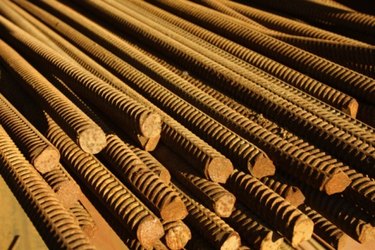
Concrete is a building material that yields great compressive strength but has little or no tensile strength. Construction practices always mandate the use of reinforcing steel in concrete structures to correct this deficiency. Rebar's design, size, type and layout including how it is spliced (connecting one bar to another by lapping, mechanical coupling or welding) in concrete walls, slabs, columns and footings is critical to a building's structural integrity. These laps are key in transferring loads to the concrete or to another reinforcing bar.
American Concrete Insitute
Video of the Day
The ACI develops standards and procedures relating to the inspection, code requirements, testing, manufacture, design, repair, placement, maintenance and research of concrete materials used in concrete structures, bridges, highways and other heavy construction. It is one of the world's leading authorities on concrete applications. Its many chapters worldwide continue to advance concrete knowledge by conducting seminars, publishing technical documentation as well as creating and implementing certification programs.
Video of the Day
General Practices
Handling, delivery and storage of reinforcing rebar is as important as positioning and splicing it within the concrete. Deflecting and bending should be avoided during loading and unloading. It should be free of any contaminates that could interfere with or reduce bond. The architect or engineer will note the location and lengths of splices (lap, mechanical or welded) on the project's structural drawings. There are specific and detailed calculations used to determine lap splices, including splices for plain and deformed welded wire and bars, splicing column bars, uncoated and epoxy coated bars. Galvanized bars are treated as uncoated bars.
Lap Splice Variables
The strength of a lap splice depends on the following variables: type of stress--compressive or tensile; bar diameter; concrete strength; spacing of bars; concrete cover; bar position and distance from other bars. Lap splices for certain size bars are not permitted. Lap splice lengths are determined when bars of two sizes are lap spliced. Lap splices should be avoided at critical design stresses, which are tensile in nature. Girder and beam splices should be made where stress is minimal. Certain conditions call for separate splice bars (dowels) to be used when splicing column bars. Certain other requirements must be met when cutting bars receiving mechanical, welded or lap splices.
Lap Splice Problems
More complex and demanding building designs have made it necessary to find alternatives to lap splicing because of the following and other problems with lap splices. Limited numbers may only be joined in one section. Rebar congestion can occur in overlapping connecting areas, which may restrict the flow of concrete. Deteriorating concrete can cause lap splice failure because lap splices depend on the concrete for load transfer whereas a mechanical splice does not. Cyclic performance in the inelastic range is poor as well as along coastal regions and in snowbelt areas.